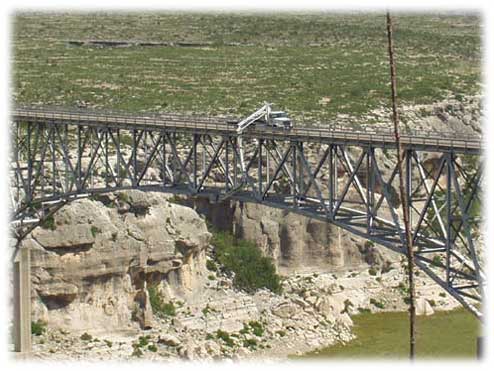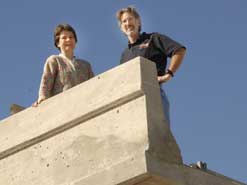
By Daniel J. Vargas
AUSTIN, Texas - The nation's aging highway bridges could become safer structures using state-of-the-art wireless monitoring and inspection systems being developed through a multi-million-dollar grant to an engineering team from The University of Texas at Austin, National Instruments and Wiss, Janney, Elstner Associates, an engineering firm based in Northbrook, Ill.

The National Institute of Standards and Technology recently awarded the research team $3.4 million to develop the bridge monitoring systems. Including matching funds, the budget for the five-year research project doubles to about $6.8 million.
Civil, electrical and mechanical engineers from the Cockrell School of Engineering will work with engineers from the collaborating companies to develop two wireless monitoring systems. The work will draw on strengths in structural engineering and innovation in the school where faculty have an international reputation for successful large-scale laboratory testing and field monitoring of bridges.
The United States has about 600,000 highway bridges. Twenty-five percent were rated as structurally deficient or functionally obsolete in 2007, according to the Federal Highway Administration. About one-third of all bridges are 50 years or older.
Sharon L. Wood, the principal investigator and the chair of the Department of Civil, Architectural and Environmental Engineering, said the award will allow for the development of two wireless network systems that together will address a critical issue for bridge safety - the monitoring of cracks or defects and corrosion in key structural components.
"This project will not only transform the evaluation practices used for highway bridges today, but will dramatically advance the state of the art in wireless sensing technology," Wood said.
The group will first develop a system for existing bridges consisting of a network of low-power, wireless sensors designed to continuously monitor bridges deemed fracture-critical — those susceptible to collapse from the failure of a single critical component. The sensor nodes will harvest their own energy via solar or wind energy or vibrations in the bridge structure, Wood said, freeing them from the electric power grid. The nodes will be capable of supporting multiple sensors and will have sufficient computing power to process raw sensor data, detect events, and send notifications to a central, off-site location when a level of damage occurs.
"What we'll be doing is real-time monitoring of the bridge," Wood said.
The researchers will develop a second system to embed in new bridges as they are built. This system will consist of passive sensors designed to detect early signs of corrosion - the most common type of damage which cannot be seen by visual inspection - in reinforced concrete bridge decks. The sensors can be read using a wireless connection during regular bridge inspections. These robust sensors are inexpensive to produce, require no power source other than the wireless signal, can easily be dispersed throughout the entire structure during construction and will function for the lifetime of the bridge.
"Monitoring key structural components is critical to the safety of our nation's bridges and the millions of people who travel over them. National Instruments is excited to work with The University of Texas at Austin and Wiss, Janney, Elstner Associates on a solution to transform highway bridge inspection and dramatically advance wireless sensing technology," said David Potter, market development manager at National Instruments. "By using NI wireless sensor networking technology combined with the proven LabVIEW graphical programming software, we can develop a reliable and cost-effective solution capable of monitoring bridge health and detecting critical changes for the entire lifetime of the bridge."
All bridges in the United States are inspected every two years, which is federally mandated. Of its 50,000 bridges, Texas continuously monitors only tw the Fred Hartman Bridge near Houston and the Veterans Memorial Bridge near Beaumont. Together those two systems use 250,000 feet of cable, Wood said.
"This highlights the need for wireless monitoring systems, because most of the existing systems are time-consuming and labor-intensive to install and not designed for long-term monitoring," she said.

National Instruments and university engineers will develop the data acquisition hardware and software for the wireless networks and energy harvesting because they are not commercially available. They also will experiment with a variety of wireless technologies since the concrete and steel components of a bridge commonly create significant interference with wireless communications.
Once developed, Wiss, Janney, Elstner, which has more than 50 years of experience in installing instruments and monitoring structures, will implement the systems and field test them.  "As our founder Jack Janney often said, sometimes you have to 'ask the structure,'" said Gary Klein, executive vice president of Wiss, Janney Elstner. "We are delighted to be working with The University of Texas at Austin and National Instruments to find a faster, more reliable way to monitor performance of critical bridge elements."
"As our founder Jack Janney often said, sometimes you have to 'ask the structure,'" said Gary Klein, executive vice president of Wiss, Janney Elstner. "We are delighted to be working with The University of Texas at Austin and National Instruments to find a faster, more reliable way to monitor performance of critical bridge elements."
The National Institute of Standards and Technology award comes from its new Technology Innovation Program (TIP), created to support innovation, high-risk, high-reward research in areas of critical national need where the government has a clear interest because of the magnitude of the problems and their importance to society. 
Matching funds will come from all participants and include equipment from National Instruments. In addition to Wood, university researchers include: Richard Crawford, Karl Frank, Todd Helwig, Dean Neikirk and Kris Wood. more →
For more information, contact: Daniel J. Vargas, Cockrell School of Engineering, 512-471-7541, Daniel.vargas2@engr.utexas.edu; Sharon L. Wood, Cockrell School of Engineering, 512-471-4558, swood@mail.utexas.edu; or Julia Betts, National Instruments, 512-683-8165, Julia.betts@ni.com.